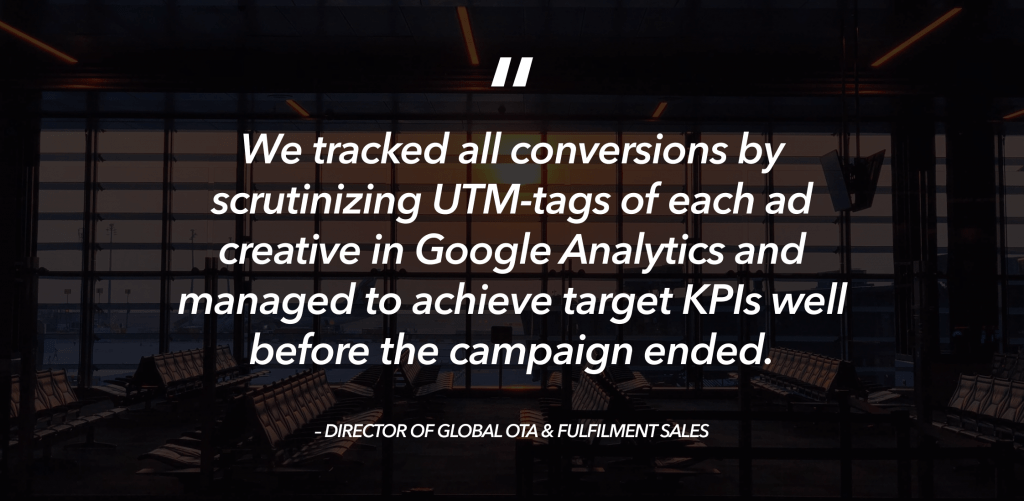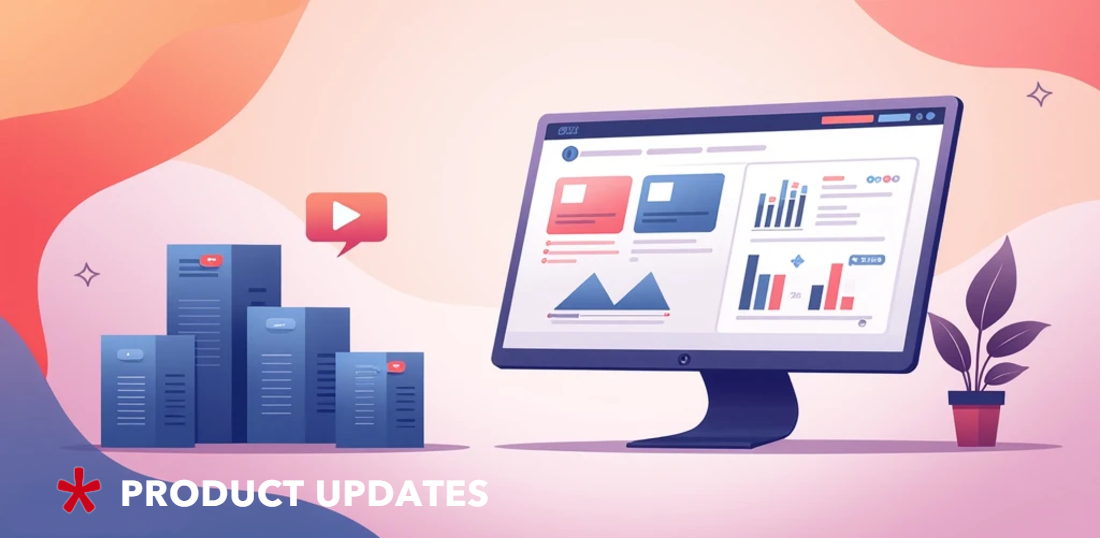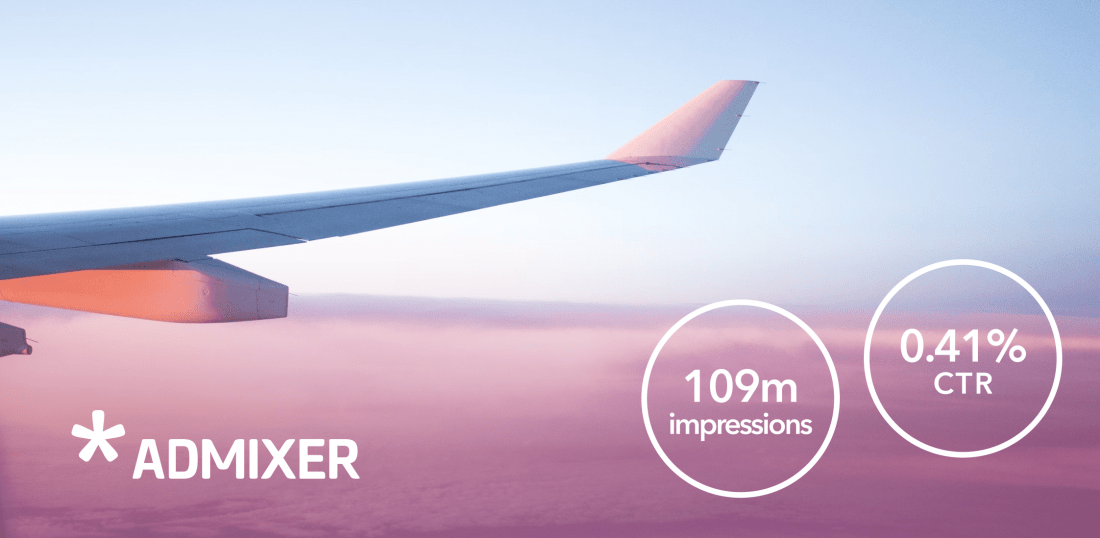
One Travel Ad Campaign, 109M Impressions: A Case Study for an Airline Business
Editor’s note: This case study describes how Admixer helped an international airline connect with travelers globally by finding and securing relevant ad inventory across our network of premium publishers, apps and CTV networks. The project falls under NDA, so we may not openly disclose the client’s name; however, we cannot help but share the key findings from this airline marketing campaign.
How do you find high-intent travelers? How do you reach them with relevant flight deals? How do you do that at the right time and place?
If you don’t have a straight answer, that makes the two of us! We recently ran a global ad campaign for an airline business, so we can relate to many challenges of travel advertising. The programmatic media buying campaign spanned 24 countries and targeted 42 audience segments in different environments, such as news & travel media sites, CTV networks and mobile applications.
But let’s spare the details for later in the article.
For now, we’d like to drive one point home: this case study is NOT a sales pitch but rather an aggregation of our experience targeting travelers around the globe. That experience gave us a lot of insights––and today, we’d like to share them with you. After all, the internet deserves at least one comprehensive document detailing good programmatic strategies for destination marketing organizations, hospitality services, trains, cruises, and international airlines.
Let’s do it.
Starting campaign on the ground
#1: Backstory
Sunday, 5 am and we get this email.
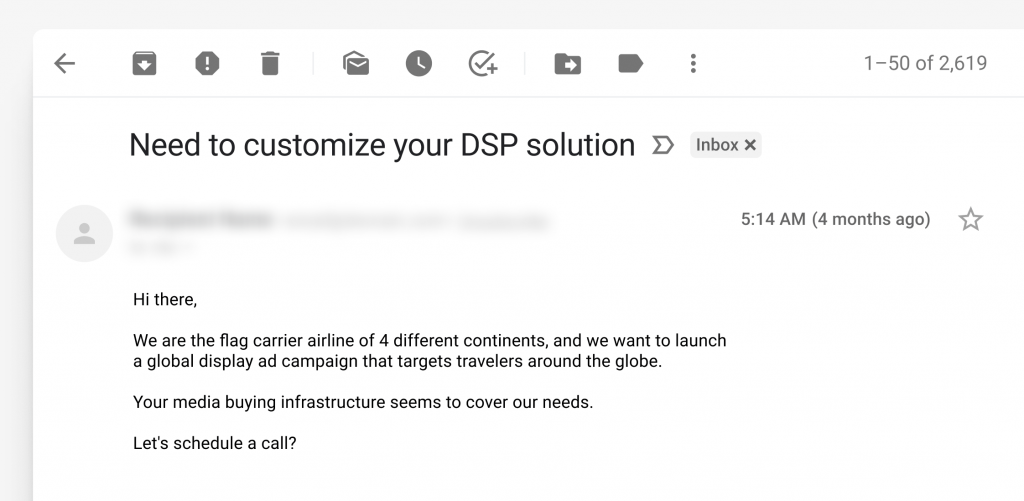
The project sounded both challenging and enticing––while we don’t specialize in airline marketing projects per se, our suite of ad tech products & services seemed to fit the bill.
The client was an international airline looking to launch a programmatic campaign and reach high-travelers in 24 countries. The airline was very well-known in their local region. But they wanted to make an impact across 20+ other countries where their competitors had a much better brand recall.
The big challenge? Being aware of all the nuances of time-sensitive inventory in the travel industry and limited by tight deadlines, we had to secure all ad inventory on the fly. We had little time for media planning. Plus, we had no first-party data provided to us by the client. With certain restrictions on targeting by GEO and other demographics data, there had to be a plan to reach relevant audiences at scale.
We had to devise a plan to make direct deals with publishers and engage in constant SPO so the client’s ads reach the right types of media inventory with little-to-zero intermediaries. Essentially, we understood the client wanted to minimize their ad spend and maximize the ROAS. So, we avoided paying for clicks while still counting them to ground their ad spend. We priced the campaign following the CPM model and optimized it by CPC.
Pro tip #1: If you’re running a global travel ad campaign connecting with travelers in many different countries, you should take the best of both worlds––price the campaign by CPM while optimizing it by CPC. Nobody deserves to overpay for their programmatic ads, so choosing the pricing model is critical.
#2: Communication mapping
Expedia Group released a 2023 report saying 78% of surveyed people make a travel choice based on ads they feel represent them through messaging and visuals. With so much information about travelers today, we face little challenges in understanding travelers and their behavior.
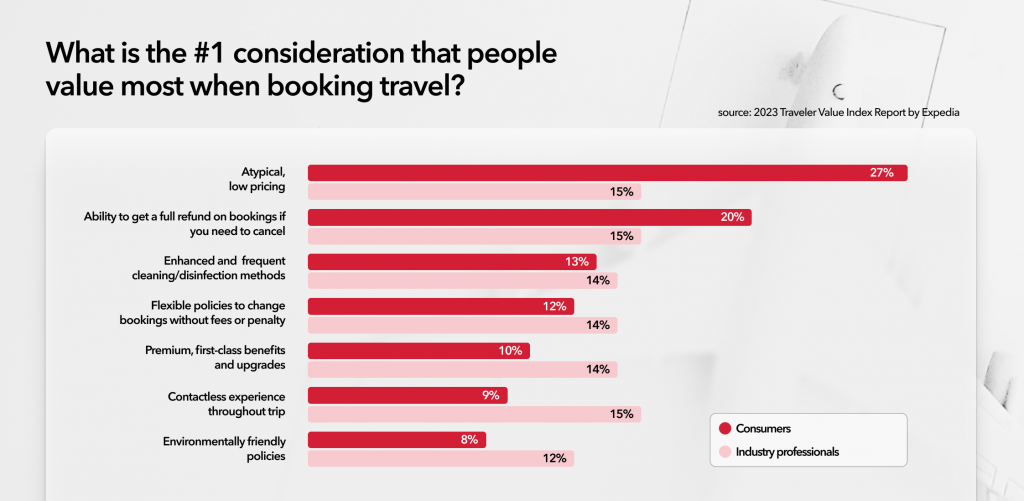
Everyone in the travel industry knows that ticket pricing and refund policy are the two primary considerations for people booking an air trip. The real hurdle we had to cross was finding the proper ad inventory to reach those high-intent travelers at the right time and environment.
How you do that?
We devised a thorough plan to secure the relevant ad inventory across a premium network of tier-1 publishers and travel sites. We analyzed which domains, travel apps and display SSPs would be relevant for the client’s audience. We sometimes negotiated with premium tier-1 publishers and made direct deals with them to win over high-quality and relevant traffic.
The only enemy left to beat was time: the client put us on rough deadlines, so we had to look for many placements on the fly (we’ll get into that later). So, we had to secure the best-performing publisher inventory while the campaign had already been running.
Pro tip #2: The best approach to travel-niche advertising is to secure the relevant ad inventory BEFORE your campaign starts. Ask the ad tech vendor to show you a complete list of secured ad placements before giving thumbs up for the campaign launch.
#3: Programmatic Media Strategy
The common myth circling among ad tech beginners is that the words “automatic” and “programmatic” could be used interchangeably. However, programmatic media buying is hardly a plug-in-play venture. Without due media planning, programmatic automates nothing but a drain on your budget.
As the global provider of ad tech infrastructure, we feel obliged to go beyond the standard approach where volume precedes over quality. Nobody wants to count mere ad impressions in the ROI-stringent industry standards such as travel. And the client gave us one clear KPI, i.e., to achieve the lowest CPC possible while driving sales and brand recall.
The solution? We priced all the media buying by CPM while optimizing the display ad campaign by CPC. In other words, our approach was counting clicks, not paying for them. We wanted to ground the client’s ad spend by doing a lot of tweaking and campaign optimization moves on-the-fly.
We ran an extra mile and made direct deals with publishers to leverage their first-party data and target high-intent travelers with laser-precise targeting. Our in-house team spent a great deal of time ensuring the airline got high-quality impressions and clicks from the right people at the right time and place.
Pro tip #3: Any airline business owns thousands of data sets about its target audience. If you find a way to integrate that data into whatever ad tech solution you’re using, you will open the floodgates to a much broader stream of high-intent buyers and impressive ROAS metrics.
Ad creatives taking off in the air
The airline industry demands pricing to be adjusted dynamically if you want to surpass the competition. Low pricing remains the #1 concern for travelers, so we had to constantly upload new creatives showcasing different prices, GEOs and flight deals.
The pie chart below shows all 24 countries where the campaign has spanned:
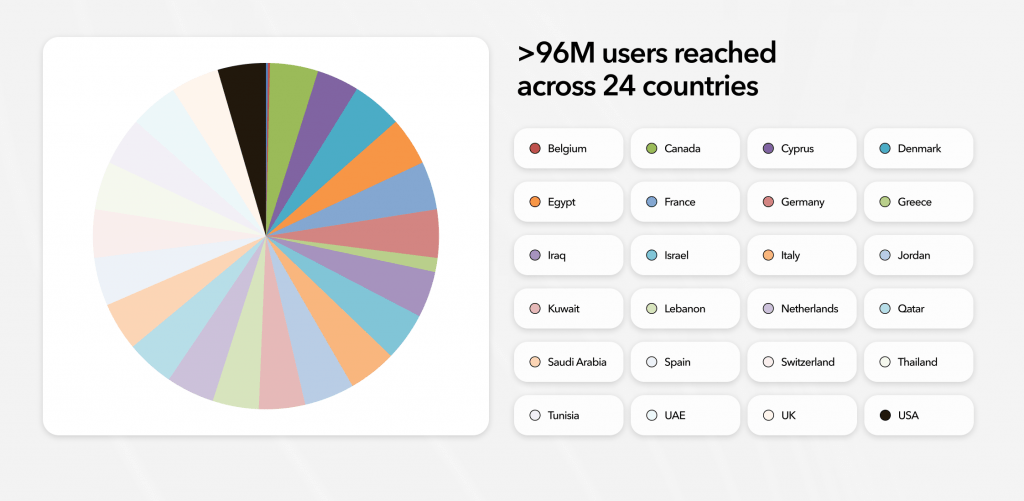
The travel industry is unique in that prices change frequently based on availability, promotions and other seasonal parameters, so we had to constantly change the ad creatives information based on time, place and travel audience segments.
Here comes the part where we tell you about the Admixer DCO solution.
The dynamic creatives builder was the solution that allowed us to launch hundreds of multilingual visuals within one single interface. Instead of uploading each creative individually, the DCO solution enabled us to launch ads in bulk. Not to mention the ability to optimize each creative on-the-fly configuring preferred languages, triggers and targeting scenarios.
Ultimately, DCO allows you to automate the advertising process and save time while creating personalized messages at scale.
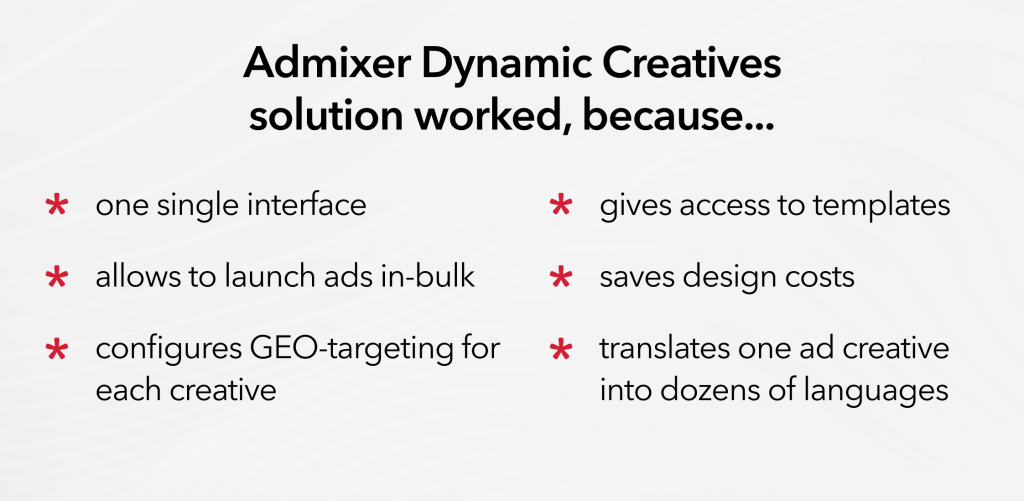
Pro tip #4: To run a multilingual media buying ad campaign, you’d need to localize creatives to represent them through relevant messages and visuals. For that, the DCO solution may be just the missing piece!
Programmatic engines on
If you think programmatic takes manual work out of the equation, you could hardly be more wrong. While automated algorithms aggregate media and data sets into one system, publisher-side inventory controls work non-stop to increase advertising costs.
That’s why we made campaign optimization our daily routine.
Every day started for us with a report and lots of data to scrutinize in real (RTB) or near-real time. For instance, we stopped those media placements that performed poorly and doubled down on ad inventory that generated the highest number of clicks.
Following the probability theory, the Admixer admin panel gave us insights, so we had a clear view of which placements had performed the best over a 7-day timeframe. We knew which ad placements drive the highest user engagement (or clicks) and made educated decisions based on the hard data provided by the Admixer technology.
Pro tip #5: Running ads for an international air carrier means fastening your seat belt tight and making campaign optimization your daily routine.
Landing in the destination
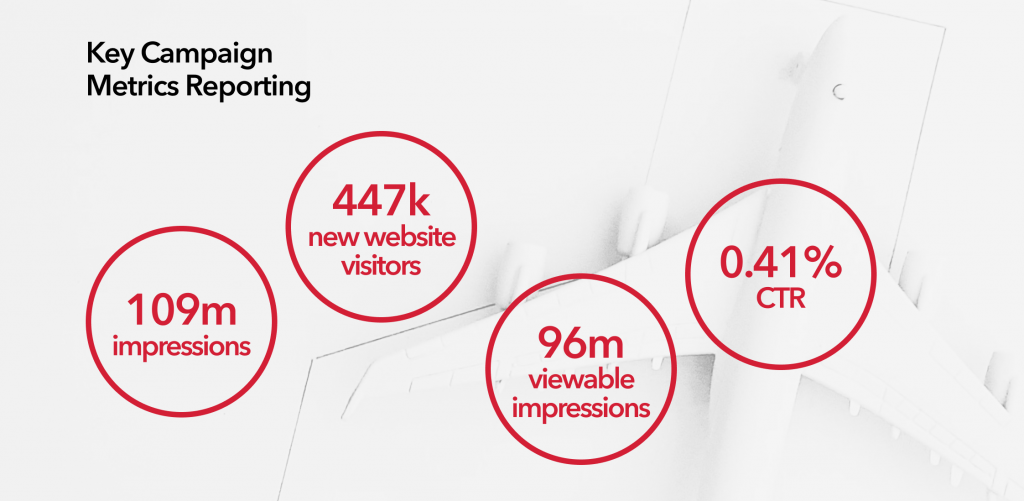
As the global programmatic platform, the magic of this ad campaign lies in our solid ad tech infrastructure. From targeting and ad creative features on the “buy” side to billions of impression opportunities on the “sell” side –– we had all the tools to make this campaign a success story.
The Admixer team of Client Success & Ad Ops Managers took extreme measures to ensure the campaign met the client’s objectives by leveraging our ad tech products and services. Over decades of experience, we’ve worked across many industries, but travel-niche companies reap the benefits of Admixer tech exceptionally well.
Is there anything else to add? We think not –– numbers speak louder than words..unless these words come on behalf of the very client:
